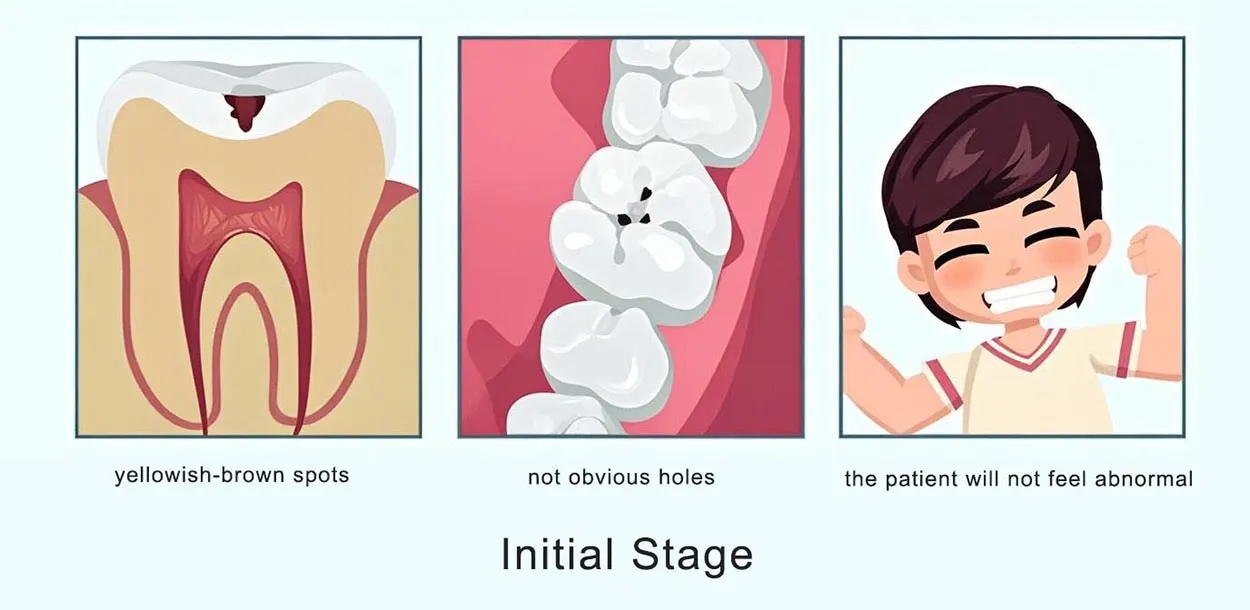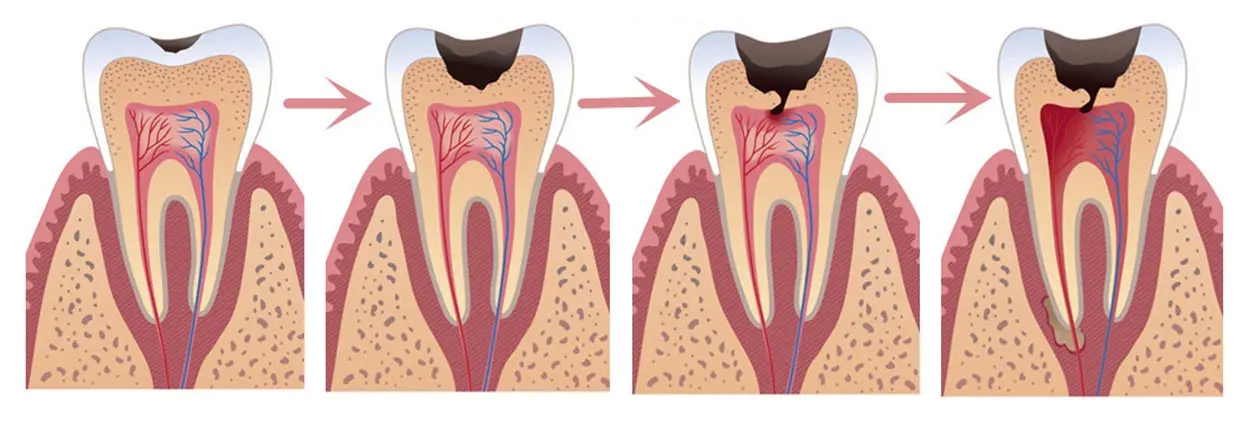When we were asked to brush our teeth or not to eat too much sugar in childhood, we must have heard the word “tooth decay” at the same time, and its medical term is “dental caries”. In this article, we will discuss in depth about dental caries, from causes and manifestations to prevention methods, to help you better understand and protect your oral health.
1. What is the caries in dentistry?
Dental caries, commonly name as “tooth decay” or “cavities”, is caused by bacteria. In layman’s terms, the bacteria in your mouth break down food particles and produce acid, which wears away the outer layers of the teeth (enamel and dentin), creating small holes. If not treated, the bacteria can spread into the nerves of the tooth, causing pulpitis (with severe tooth pain). The infection can then move to the tooth roots, leading to periapical inflammation, and may even affect the alveolar bone and jawbone. After some time, the decay worsens, forming larger cavities, finally the crown of the tooth may be completely destroyed, resulting in tooth loss. Caries do not resolve without intervention.
Dental caries is the most common chronic disease in dentistry. It is caused by a combination of factors that gradually damage the hard tissues of the tooth. The disease is widespread and can occur in baby teeth, developing permanent teeth and fully formed permanent teeth, so people of all ages can be affected. Moreover, children and the old man are more susceptible to dental caries. The World Health Organization(WHO) has ranked dental caries as one of the three major human diseases, along with cancer and cardiovascular disease.
2. What is the pathogenic mechanism of dental caries?
The theory currently accepted by the dental community is the “four elements of tooth decay” discovered by Prof. Keyes’ team and Dr. Newbrun, i.e., the formation of dental caries is the result of a combination of four factors: bacteria, host, diet and time:
- Caries-causing flora: acid-producing bacteria such as Streptococcus mutans and Lactobacillus form biofilms.
- Suitable host: anatomical defects in the teeth, salivary secretion abnormalities.
- Carbohydrates: especially fermentable sugars such as sucrose.
- Accumulation of time: plaque retention for more than 48 hours triggers demineralization.
Predisposing factors
Protein deficiency during tooth development (from birth to 6 months) can lead to abnormal development of salivary glands, thus depriving teeth of salivary protection and predisposing them to caries.
As the elderly age, the gums begin to shrink and the root surfaces of the teeth are exposed, making it easy for bacteria to gather, often resulting in root surface caries.

3. What are the typical symptoms of dental caries?
Initial stage:
Healthy teeth should be smooth and shiny like ceramics, but when tooth decay occurs, it will lead to loss of luster on the surface of the teeth and accompanied by white plaques, or it may be stained by food pigmentation to become yellowish-brown spots. At this time, the teeth are like the wall eroded by rainwater appears chalking, at this time the teeth are not obvious holes, the patient will not feel abnormal.

Intermediate stage:
Early not found in time to deal with the caries problem will gradually aggravate. At this stage the surface of the tooth begins to appear small holes, like a small insect infested wood. At this time the teeth will be particularly sensitive to temperature changes and sweet and sour foods. Hot, cold, and sweet and sour foods can cause the tooth to tingle, and these tingles will be relieved when the source of the irritation is removed.

Later stages:
When cavities progress to the later stages, the holes in the teeth become large and deep, reaching into the dentin, the innermost layer of the tooth. At this point, the tooth resembles a tree that has been hollowed out. It reacts more sharply to hot and cold stimuli and the pain lasts longer. Sometimes there is spontaneous pain without external stimuli.

Stages of Caries Development Comparison Table
| Classification | Lesion Depth | Clinical Manifestation |
|---|---|---|
| Shallow Caries | Enamel Layer | White spot / Yellow-brown spots, rough feel on probing |
| Moderate Caries | Superficial Dentin | Obvious cavity, sensitivity to hot and cold stimuli |
| Deep Caries | Deep Dentin | Large and deep cavity, precursors to spontaneous pain |
4. What are the clinical classifications of dental caries?
According to the rate of progression
- Acute caries: progresses rapidly, with carious tissue that is wet and soft, yellowish brown, and soft and easy to excavate. It is common in children, adolescents or immunocompromised individuals and may lead to pulpal infection in the short term.
- Chronic caries: progresses slowly, carious tissue is dark brown and hard. Most common in adults, the edge of the cavity is hardened by remineralization, and the symptoms are less severe.
According to anatomical site
- Fossa caries: occurs in the fossa of the occlusal surface of the teeth, commonly found in the molars and bicuspids. The fossa structure is easy to retain food debris and bacteria, which is difficult to clean in the early stage and the caries progresses faster.
- Smooth surface caries: It occurs in smooth areas such as buccal, lingual or labial surfaces of the teeth, and is mostly related to plaque accumulation. It is common in people with poor oral hygiene, and is characterized by chalky plaque in the early stage.
- Root surface caries: It occurs on the root surface of the tooth after gingival recession, and is easy to form ring caries because of the weak acid resistance of the tooth bone. Commonly found in the elderly or patients with periodontal disease.
5. What are the treatment solutions for dental caries?
Early intervention
- Early decay restoration: 75% sodium fluoride glycerin paste and 8% tin fluoride topical coating are commonly used. Fluoride is like putting a protective coat on the teeth. This treatment is safe as it neither damages the gum tissue nor changes the color of the teeth.
- Milk teeth treatment: Silver ammonium fluoride drops can effectively stop the development of tooth decay with a high safety factor, especially suitable for milk teeth treatment.
- Remineralization treatment: Fluoride-containing preparations + calcium and phosphorus supplements help remineralize and harden teeth that have been demineralized. It is like a calcium supplement for teeth and is suitable for the early stages of dental caries. It has been found that the best restorative effect is achieved when the ratio of calcium to phosphorus in the preparation is 1.63:1.
Restoration of tissue defects
- Minimally invasive preparation: Repairing cavities with resin materials close to the color of the teeth, which can perfectly match the color of the teeth, suitable for front teeth that need to be restored both aesthetically and practically.
- Fossa sealing: Fill and seal the uneven fossa areas on the biting surface of the teeth with a flowable resin material. It is like putting a protective shield on the teeth to prevent food debris and bacteria from entering to deepen the caries.
Functional Reconstruction:
- Inlay/Full Crown Restoration: Customized and personalized inlays are required when the extent of decay is extensive. This restoration will fit snugly into the tooth like a jigsaw puzzle, restoring the shape of the tooth and re-establishing normal occlusal contact.
6. How can caries be prevented?
Three-tier prevention system
Level Ⅰ prevention (etiologic prevention)
Regular oral examination: at least one comprehensive oral examination per year, receive a professional scaling, and pay attention to a balanced diet in general.
Scientific brushing: Brush your teeth with fluoride toothpaste once a day in the morning and once a day in the evening, and rinse your mouth after meals.
Control the intake of caries-prone foods: all kinds of candies, cakes, cookies and other high-sugar foods. It is recommended to eat more fresh vegetables such as celery, carrots and foods rich in dietary fiber, which can help to clean the teeth during the chewing process.
Level II Prevention (Early Diagnosis)
Emphasize the early symptoms of tooth decay, and go to the dentist for checkups when you notice blackened tooth surfaces and teeth becoming sensitive. It is best to check every six months for early detection and treatment to avoid aggravation of caries and injury to the tooth nerve.
Level III prevention (functional recovery)
For serious caries that has already appeared larger cavities, root canal treatment should be carried out in a timely manner and the defect should be repaired to prevent the spread of infection triggered by gum swelling and pain, nerve pain or even the development of a serious situation that requires tooth extraction.
7. FAQs
Q1. Is dental caries another term for tooth decay?
Yes, they are the same concept. Tooth decay is a common name and caries is a medical term.
Q2. How does a doctor diagnose caries?
When a chipped hole appears on the surface of a tooth, the doctor will use a probe to examine the bottom of the black hole. Or through X-rays, you can see that the caries area is significantly less dense than the surrounding healthy teeth.
Q3. How do dentists treat dental caries?
Modern techniques like using a dental drill to remove decayed tissue, acid etching, bonding, and resin fillings can effectively remove the infected material and restore the tooth.
Q4. Can caries be cured?
Early enamel caries can be reversed, restorative treatment is needed after caries cavities form, and timely intervention can lead to complete healing
Q5. What is the special consideration for caries?
Children who have had their sockets closed need to be re-examined every six months to check whether the sealing material is intact, and if it is found to have fallen off, it should be re-sealed in time to ensure the effect of caries prevention.


